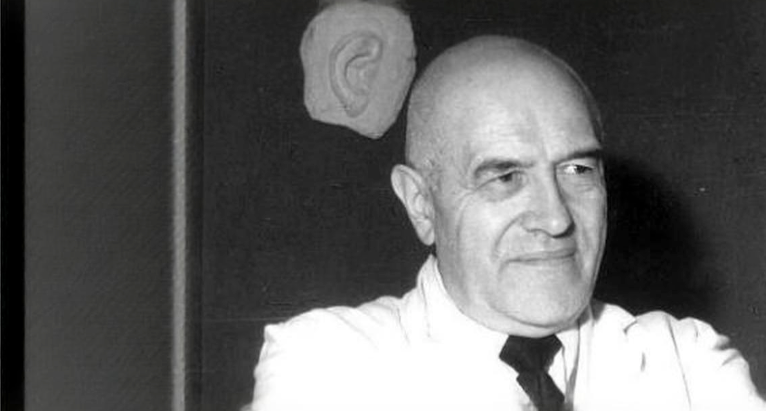
Dr. Paul NOGIER
Dr Paul Nogier was a general practitioner who particularly practiced natural medicines : acupuncture, homeopathy, psychotherapy, manual medicine.
His mastery of these techniques led him to discover auriculotherapy in 1951, then later to develop auriculomedicine.
His research on auriculomedicine led him to test several devices, which is how Dr. Paul Nogier discovered 7 frequencies to which every living organism is sensitive . These frequencies are information emitted or received by the organism and therefore allow for a diagnostic or therapeutic effect.
The results of his research and work are now taught throughout the world.

HOW DO HYLOS SOUNDS ACT ON YOUR STRESS?
Let's make an analogy with electrotherapy: the current used is of the order of milliamperes, almost imperceptible to the body .
A strong electric current would cause a defensive reflex reaction .
Likewise, the low intensity of Hylos sounds allows them to flow without resistance .
WATER in the body, vector of sound waves.
The water share is about 65% of the total weight of an adult individual.
It is through the water that is present throughout the body that the vibrations of Hylos penetrate into the cells, where they need to go to carry out their relaxation work.
NOGIER FREQUENCIES
Seven frequencies were experimentally developed by Doctor Paul Nogier around the 1970s. These frequencies are constantly used in current medical practice because they are preferentially recognized by the body. They resonate with certain biological receptors and have their own effect on the body.
- Frequency A: 292 Hz; action at tissue level: wounds, epithelial tumours, epidermal reactions, etc.
- Frequency B: 584 Hz; metabolic and digestive problems: trophic functions, parasympathetic polarity, interoceptive influxes, etc.
- Frequency C: 1168 Hz; locomotor problems: ergotropic function, orthosympathetic polarity, etc.
- Frequency D: 2336 Hz; laterality disorders.
- Frequency E: 4672 Hz; pain and nerve conduction: spinal cord disorders.Frequency F: 73 Hz; brain and bone reconstruction.
- Frequency G: 146 Hz; action on the cerebral cortex: cortical and psychic disorders...
Definition of frequencies by Dr. Paul and Raphaël Nogier: Extract from “The Man in the Ear”, Maisonneuve, 1979, 255 p.
Collapsible content
Frequency “A”
In the animal kingdom, it is attached to unorganized structures, to everything that is embryonic. It is the frequency of the primitive living being; it is in sympathy with the cell in its raw, undifferentiated state. This frequency, the most archaic, is also the most anarchic, if I may say so.
→ Action at tissue level: Wounds, epithelial tumors, epidermal reactions, etc.
Frequency “B”
More elaborate, is specific to the visceral nutritive system; it echoes the primary digestive system.
→ Metabolic and digestive problems: Trophic functions, parasympathetic polarity, interoceptive influxes, etc.
The frequency “C”
Signals the motor elements of the organism. It is the reflection of movement, limbs, renal system, genital system.
→ Locomotor problems: Ergotropic function, orthosympathetic polarity, etc.
The “D” frequency
Leads us to an even more evolved organization. It introduces the notion of symmetry, by selectively affecting certain so-called "odd" organs, whose characteristic is to be unique but anatomically symmetrical - for example the corpus callosum or the white commissure, two symmetrical cerebral formations, located between the right hemisphere and the left hemisphere.
→ Laterality disorders
The frequency “E”
Is that of the spinal cord, of the central nervous system, which perceives and makes the more or less layered functional units communicate with each other.
→ Pain and nerve conduction: spinal cord disease
The frequency “F”
Represents the subcortical brain regions. These formations are found in the brains of evolved animals, such as dogs.
→ Brain and bone reconstruction
The “G” frequency
It resonates with the most elaborate structures of the organism, those of the cerebral cortex, a typically human part of the brain, which gives man the capacity to think, create and imagine.
→ Action on the cerebral cortex: Cortical and psychological disorders, etc.
Hylos sounds contain all the frequencies of NOGIER, which is why the same sound is valid for everyone regardless of the users' symptoms.
Sound frequencies penetrate directly into the body, they do not address hearing, but directly to the cells . Their emission level is so low that we do not hear them.
For humans and animals: Hylos offers two different programs with the same sound, one for humans and the other for animals.
Indeed, humans and animals do not react in the same way to Hylos sounds , which is why we have made two adapted programs.
